#washita
Photo
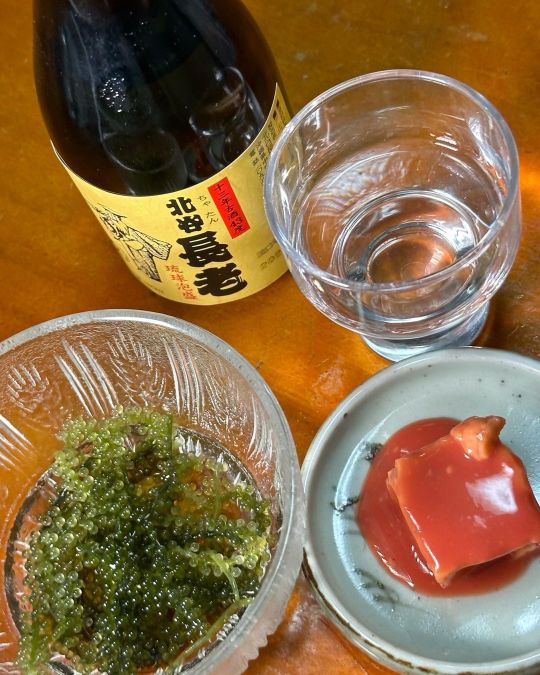
Hmmm #delicious #tofu #sea pudo #chatan elder #ryukyu awamori #Okinawa #ginza #washita shop main store う〜ん #美味しい #豆腐よう #海ぷどう #北谷長老 #琉球泡盛 #沖縄 #銀座#わしたショップ本店 (Yokohama) https://www.instagram.com/p/Cm79C8RvZ3W/?igshid=NGJjMDIxMWI=
0 notes
Text
Ouachita/ Washita Mound
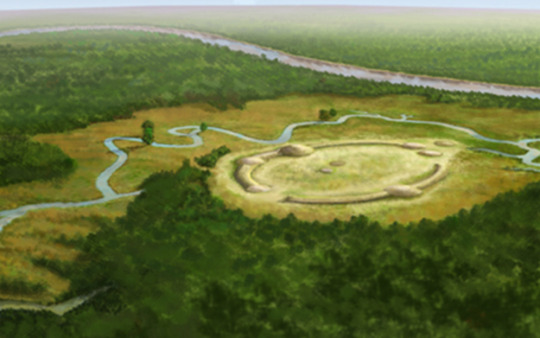
All rights held by the artist, Herb Roe© 2020
Ouachita (Washita)
The Ouachita mound site is the earliest known mound site. It is situated in the northeastern part of the state of Louisana at a place called Watson Brake. It dates back to 5400 years ago. It consist of 11 differently sized raized mounds configured into a semi-circle. It is raized high enough to overlook the Ouachite river. It is believed this sites dates back before the advent of agriculture in North America and there has yet to be any evidince the mounds were used as burial site or contain artifacts. It is possibly the design is purely for defence. During the famous Ouachita expedition led by William Dundar this site and others were passed by because the expedition did not venture far away from the Ouachita river
Reference:
1491 BY Charles C Mann page 291,292
Hidden Cities by Roger Kennedy page 195, 196
Written by Michelle Evans
2 notes
·
View notes
Text
i started reading A Terrible Glory and it said there was peace in the Northern Plains for a while bcs of a “stunning cavalry victory on the Washita River” and i had to put it down because. stunning victory at the Washita River? victory? at the fucking Washita Massacre? there was nothing to be victorious for, it wasn’t even a battle??!?!?? i mean i guess if you count the Cheyenne warriors fighting back after their camp got AMBUSHED then sure????
like i don’t think the book is presenting Custer’s “victory” as a good thing but i’m stunned you’d even refer to it as a victory considering it was a massacre, rather than a real battle imo. you wouldn’t call what the Colorado Cavalry did at Sand Creek a fucking victory now would we
#Psy's no punctuation posts#i understand Wikipedia still calls it a battle but hard disagree i think Washita Massacre is a more accurate reflection of the event#i don't knowww i don't know that really put me off#like i just??? VICTORY??????????
2 notes
·
View notes
Text
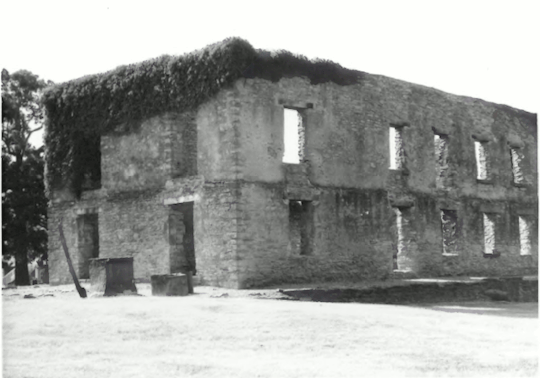
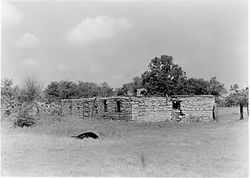
Spooktober Haunted Oklahoma: Fort Washita in Durant #hauntedplaces #fortwashita #Durant #oklahoma #durantoklahoma #spooktober #halloween #october
0 notes
Text
Atrocity created by CAPITALISM
Irish Famine (1845-1852)
Indian Famines during British colonial rule (Various, 18th-20th centuries)
Indigenous Genocide (Ongoing since colonization)
Slavery (16th-19th centuries)
Indonesian Genocide (1965-1966)
Pinochet Dictatorship (1973-1990)
Argentina Dictatorship (1976-1983)
Brazilian Dictatorship (1964-1985)
Pakistan Incident (Bangladesh Genocide, 1971)
The Gilded Age (Late 19th century)
The Great Depression (1929-1939)
Operation Condor (1960s-1980s)
Banana Wars (Early 20th century)
Batista Dictatorship (1952-1959)
Guantanamo Bay (Ongoing since 2002)
Vietnam War (1955-1975)
My Lai Massacre (1968)
Sinchon Massacre (Korean War, 1950-1953)
Kent State Massacre (1970)
Patriot Act (2001)
Red Summer (1919)
Jim Crow (Late 19th-20th centuries)
MK Ultra (1950s-1970s)
1985 MOVE bombing (1985)
1921 Battle of Blair Mountain (1921)
Malayan Emergency (1948-1960)
Mau Mau Rebellion (1952-1960)
Covert war in Yemen (Ongoing)
Stanley Meyer incident (1998)
Genocide in Turkey (Armenian Genocide and others, WWI era)
Congolese Genocide (Late 19th-20th centuries)
Greek Civil War (1946-1949)
Invasion of Cyprus by Turkey (1974)
Washita River Massacre (1868)
Minamata Disaster (1950s-1960s)
Bhopal Disaster (1984)
Kentler Project (1960s-2003)
Thomas Midgley Jr. and leaded gasoline (Early 20th century)
Forced labor in private US prisons (Ongoing)
Collateral murder in Iraq (2010)
Julian Assange and leaks (Ongoing)
US drone strikes (Ongoing)
US sanctions (Ongoing)
US support for dictatorships (Ongoing)
Korean War and civilian casualties (Korean War, 1950-1953)
Nazi funding and collaboration (WWII era)
Hitler and "Judeo-Bolshevism" (WWII era)
#communism#anarchism#marxism leninism#marxism#leftism#socialism#politics#american politics#government#republicans#us politics#conservatives#capitalism#social issues#poverty#anti capitalism#late stage capitalism#eat the rich#leftist#corporate greed#fuck capitalism#kill the rich#eat the fucking rich#fuck billionaires
372 notes
·
View notes
Photo
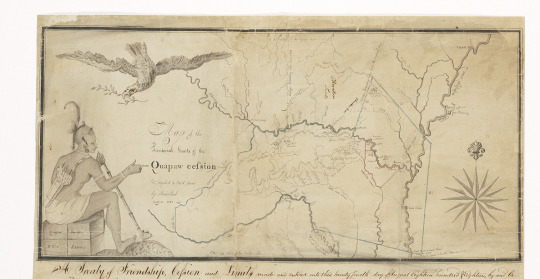

Treaty Between the United States and the Quapaw Indians Signed at St. Louis, August 24, 1818.
Record Group 11: General Records of the United States Government
Series: Indian Treaties
File Unit: Ratified Indian Treaty 96: Quapaw - St. Louis, August 24, 1818
Image description: Detailed map of the area of Arkansas River and Mississippi River, with boundaries of red and blue; with an eagle on top left carrying olive branch in its beak; a Native American with a peace pipe on the left, presumably of the Quapaw tribe, pointing to the inscription:
Map of the Territorial Limits of the Quapaw cession
Compiled & Laid down by Rene Paul
August. 1818
Transcription:
[image: Detailed map of the area of Arkansas River and Mississippi River, with boundaries of red and blue; with an eagle on top left carrying olive branch in its beak; a Native American with a peace pipe on the left, presumably of the Quapaw tribe, pointing to the inscription:
Map of the Territorial Limits of the Quapaw cession
Compiled & Laid down by Rene Paul
August. 1818]
A treaty of Friendship, Cession and Limits made and entered into this twenty fourth day of August Eighteen hundred & Eighteen, by and be-
tween [between] William Clark and Auguste Chouteau, Commissioners on the part and behalf of the United States of the one part, and the Undersigned Chiefs,
and Warriors of the Quawpaw Tribe or Nation, on the part and behalf of this said Tribe or Nation of the other part. -
Art: I: The Undersigned Chiefs and Warriors for themselves and their s'd [said] Tribe or Nation do hereby acknowledge themselves to be under the protection of the United States, and
of no other State, Power, or Sovereignty whatsoever.
Art: II: The Undersigned chiefs and Warriors, for themselves and their said Tribe or Nation do hereby, for an in consideration of the promises and stipulations herein after named, Cede
and relinquish to the United States forever, all the Lands within the following boundaries, viz: Beginning at the mouth of the Arkansas River, thence extending up the Arkan-
saw [Arkansaw] to the Canadian fork and up the Canadian fork [to its source, thence south to Big Red river and down] that river to the Big raft, Thence a direct line so as
to strike the Mississippi River, thirty Leagues in a straight line below the mouth of Arkansaw, together with all their claims to land East of the Mississippi, and north of the Ar-
kansaw river, included within the couloured lines, 1, 2, and 3 on the above map: - with the exception and reservation following: that is to say, the tract of country bounded as follows;
Beginning at a point on the Arkansaw river opposite the present post of Arkansaw, and running thence a due South West course to the Washita river, thence up that river to the
[in pencil, faint] mouth of the Saline [/] Saline fork, and up the Saline fork to a point from whence a due North East course would strike the Arkansaw river [insert] at the little rock [/] and thence down the right bank of the Arkan-
[in margin, circled] 2-9 [/] saw to the place of beginning, which S'd [said] tract of land, last above designated and reserved, shall be surveyed and marked off, at the Expense of the United States, as
any State or Nation, without the approbation of the United States, first had and obtained.
Art III; It is agreed between the United States, and the said Tribe, or Nation, that the individuals of the S'd [said]Tribe or Nation shall be at liberty to hunt within the Territory by them
ceded to the United States, without hindrance or molestation so long as they demean themselves peacefully and offer no injury or annoyance to any of the citizens of the United
States, and until the S'd [said] United States may think proper to assign the Same, or any same or any portion thereof, as hunting grounds to other friendly indians.
Art IV; No Citizen of the United States, or any other person shall be permitted to settle on any of the lands hereby allotted to and reserved for the S'd [said] Quawpaw Tribe, or Nation, to live and
hunt on; Yet, it is expressly understood and agreed on by and between the parties aforesaid, that at all times the citizens of the United States, shall have the right to travel
and pass freely without toll or exaction through the Quawpaw reservation, by such roads or routes as now are, or hereafter may be, established.
Art V; In consideration of the cession and stipulations aforesaid the United States do hereby promise, and bind themselves to pay and deliver to the s'd [said] Quawpaw Tribe, or Nation, immediately
upon the execution of this Treaty, Goods and Merchandise to the value of Four Thousand Dollars, and to deliver, or cause to be delivered to them yearly, and every year, Goods and Mer-
chandise [merchandise] to the value of One Thousand Dollars to be estimated in the city, or place in the United States, where the same are procured, or purchased.
Art VI; Least the friendship which now exists between the United States, and the Said Tribe, or Nation should be interrupted by the misconduct of individuals, it is hereby agreed, that
for injuries done by individuals, no private revenge, or retaliation shall take place, but instead thereof, complaints shall be made by the party injured to the other. - By the Tribe, or
nation aforesaid, to the Governor, Superintendant of Indian Affairs, or some other person, authorized or appointed for that purpose, and by the Governor, Superintendent, or other person authorized
to the [crossed out] said [/] Chiefs of the S'd [said] Tribe, or Nation. And it shall be the duty of the Said Tribe or Nation, upon complaint being made as aforesaid, to deliver up the person or persons against whom the complaint is made, to the end that he or they may be punished agreeably to the Laws of the State or Territory where thee offence may have been committed; And in like manner, if any robbery,
violence, or murder, shall be committed on any indian, or Indians belonging to the Said Tribe, or Nation, the person, or persons so offending shall be tried, and if found guilty,
punished in like manner as if the injury had been done to a white man._ And it is further agreed that the chiefs of the said Tribe or Nation shall to the utmost of their power
exert themselves to recover horses or other property which may be Stolen from any citizen or citizens of the United States, by any individual or individuals of the Said Tribe, or
Nation, and the property so recovered shall be forthwith delivered to the Governor, Superintendent, or other person authorized to receive the same, that it may be restored
to the proper owner. And in cases where the exertions of the Chiefs shall be ineffectual in recovering the property stolen, as aforesaid, if sufficient proof can be obtain-
ed [obtained], that such property was actually stolen by an indian, or indians belonging to the Said Tribe, or Nation, a sum equal to the value of the property which has been stolen, may
be deducted by the United States from the Annuity of S'd [said] Tribe or Nation. And the United States hereby guarantee to the individuals of the Said Tribe, or Nation
a full indemnification for any horse, or horses, or other property which may be taken from [insert] them [/] by any of their citizens; Provided, the property so stolen cannot be recovered, and
that sufficient proof is produced that it may actually stolen by a citizen or citizens of the United States.
Art VII; This Treaty shall take effect and be obligatory on the contracting parties, as soon as the same shall have been ratified by the President of the United States,
by and with the advice and consent of the Senate.
[left column]
Done at St Louis in the presence of
[signed] R. Wash Secretary to the Commission
[signed] R. Paul Col. M. M.
C. I.
[signed] Jn Ruland Sub Agent & c
[signed] R Graham Ind Agt
[signed] M Lewis Clark
[signed] J. T. Honore Ind Intpr
[signed] Joseph Bonne Interpreter
[signed] Julius Pescay
[signed] Stephen Julian, U.S. indn interpt.
[signed] James Loper
[signed] William P Clark
[middle column]
[signed] Wm Clark
[signed] Aug. Chouteau [seal]
Kra-ka-ton, or }
the dry man } his + mark [seal]
Hra-da-paa, or }
the Eagles Bill } his + mark [seal]
Ma-hra-ka, }
or Buck Wheat } his + mark [seal]
Hon-ka-daq-ni his + mark [seal]
Wa-gon-ka-datton his + mark [seal]
Hra-das-ka-mon-mini, }
or the Pipe Bird } his + mark [seal]
Pa tonq di, or the }
approaching Summer } his + mark [seal]
Te hon ka, or the }
Tame Buffaloe } his + mark [seal]
[right column]
Ha-mon-mini }
or the night walker } his + mark [seal]
Washing-tete-ton }
or mocking bird bill } his + mark [seal]
Hon-te-ka-ni his + mark [seal]
Ta-ta-on-sa or }
the whistling wind } his + mark [seal]
Mozate te } his + mark [seal]
#archivesgov#August 24#1818#1800s#Native American history#American Indian history#Indigenous American history#Quapaw#Indian treaties
76 notes
·
View notes
Note
Obvio que le da color si la washita ta ma buena, si no te pesca no seas awenao

Aquí le damos todo el kolinnn
#chilean#latina#chuby girl#18+ content#arsmate#chubby#tattooed legs#tumblr chilensis#sexy titts#curvybeauty#tattogirl#18+ account#18+ only#18+ post#tsv#poto
62 notes
·
View notes
Photo

On this day, 27 November 1868, a detachment of US troops under the command of General Custer ignored orders to kill only warriors and massacred 103 sleeping Cheyenne in the so-called "Battle of the Washita". Cheyenne chief Black Kettle had requested permission from US colonial authorities to move his village near to Fort Cobb for protection. The request was refused, but Black Kettle was reassured that if his men stayed in their villages, they would not be attacked. Just before dawn the following morning, while most of the village were asleep, the US Army attacked the village. General Custer had ordered his troops "to destroy their villages and ponies, to kill or hang all warriors, and bring back all women and children." Black Kettle awoke when the attack began and lifted his hand to give a gesture of peace. He and his wife were shot dead, and their bodies ridden over by horses. In just a few minutes, the village was destroyed and hundreds of horses were shot. Rather than separate warriors, the soldiers massacred 103 people, only 11 of whom were warriors, the others being women and children. They also took 53 women and children hostage. Hearing gunfire, a detachment of Arapaho warriors came to the aid of the Cheyenne, as did some Kiowa and Nʉmʉnʉʉ (Comanche). These fighters encountered and wiped out a detachment of 17 US troops. At this point the US army withdrew with its captives. Custer was later killed by Cheyenne, Arapaho and Lakota warriors in the Battle of the Little Bighorn. https://www.facebook.com/workingclasshistory/photos/a.296224173896073/2145997845585354/?type=3
215 notes
·
View notes
Text
Little Big Man
by: dayanara ramos
There are thousands of movies released every year around the world. However, there is one gem that stands out because of its boldness and brilliance. The movie is named, "Little Big Man" (1970). The movie is directed by Arthur Penn. The movie is more than about cowboys and Indians. In fact, it deals with America's past through the eyes of one man. The movie, "Little Big Man" tells the story of Jack Crabb, someone who grew up with the Cheyenne tribe. We see Jack surviving battles, meeting famous individuals like Wild Bill Hickok, and even see the “Battle of Little Bighorn". Critics like Vincent Canby of The New York Times called the movie, "Arthur Penn's most extravagant and ambitious movie”. Another famous reviewer said, "Arthur Penn's Little Big Man is an endlessly entertaining attempt to spin an epic in the form of a yarn." Historical Context
This movie is rooted in history. It shows the clashes between Native Americans and settlers during the 19th century. Scenes like the “Washita River massacre”, where innocent women and children are slaughtered by the US Army remind us of America's complicated past. Likewise, the portrayal of renowned historical figures such as Wild Bill Hickok adds authenticity to the era of the film.
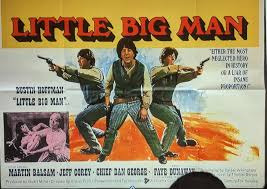
The landscapes of "Little Big Man" look breathtaking. The way the movie is filmed makes you feel like you are right there in the Old West. One wonderful scene is when Jack Crabb stands in the battle and the dust swirling around him. Also, the movie employs flashback sequences to properly highlight Jack Crabb's journey, offering evidence of his experiences and transformations. When it comes to the approach of "Little Big Man", the movie is unconventional. Even though it has all the electrifying stuff you expect from a Western—like fights and wild landscapes, it gives Native Americans a more real role. This is quite different from the usual Western story that was released before 1970. That is what makes the movie unconventional for that period. That is what makes it stand out from the rest. That is why "Little Big Man" is a movie you do not want to miss.
youtube
5 notes
·
View notes
Note
Te amo washita rica 💕😮💨 que tengas bonito día 💕
Yo te amo más amorcito mío hermosa precioso 💓 😍
2 notes
·
View notes
Photo

#Rafute Ginza #Washita shop main store #Okinawa #antenna shop #sandwich #baguette #ラフテー 銀座 #わしたショップ 本店 #沖縄 #アンテナショップ#サンドイッチ #バゲット (Yokohama) https://www.instagram.com/p/CjKzt-VLUMi/?igshid=NGJjMDIxMWI=
0 notes
Text
started reading Dragon Teeth by Crichton since my coworker is lending me Lost World in a few days and i had a couple days to kill till then since i finished Jurassic Park, and after a hundred pages i set the book down and went, "what is the point of this book?" so idk if it's going great KRKF
i think it's a great concept for a book. it's about the Bone Wars and people going out West to dig up dino bones in the 19th century, and it's told like the main character was a real guy and Crichton found, like, his unpublished writings and is writing a history book about him and . the Bones Wars guys. but really, the mc is not real, though Cope and Marsh are and it's draped in a lot of other historical figures. there's even an extensive Custer mention.
but it's just like. every scene is written like a summary, you understand what i mean? as a mock-history book, it's bad. as a fiction book, it's bad.
i like Crichton's writing, though, and i don't dislike the book, i just can recognize that it's not very good in execution at all. and what a shame! i love the Bone Wars era and i love the idea of digging up dinos in the American West and having this mc interacting with the real Cope and Marsh. it's brilliant. but i just feel like everything is being summarized to me, and i'm not really seeing like, a real book.
and that disappoints me!
also i feel uneasy about the way Crichton talks about Native peoples. cause, like, if this is to be read as a faux history book, then he's being racist. a lot of "savage" talk, and him like. oh man, the way he said Black Kettle was often argued as being an innocent and a scapegoat to justify US atrocities towards Native peoples and then going "this isn't true". i almost set the book down then and there and had to talk myself back into reading it bcs it's fiction but like. Crichton what are you saying KRKF this is like Steinbeck-level "author insert is being racist" shit and i don't like that.
the book was written in 1974, so i guess i should expect it. it just caught me off guard.
#psy's no punctuation posts#reading tag#the Black Kettle thing seriously ticked me off. Black Kettle? you're saying Black Kettle did something to justify the Washita Massacre?#BLACK KETTLE?????#get real dude.#anyone trying to justify the Washita Massacre makes my blood boil though so that's a particularly sensitive thing for me
1 note
·
View note
Photo

A marvelously structured high precipitation supercell thunderstorm in Washita County, OK in 2013 The incredible striations mark the movement of the inflow.
15 notes
·
View notes
Text
monse
monita
monitabb
montinina
monita linda
wawita
monti
washita
1 note
·
View note
Text
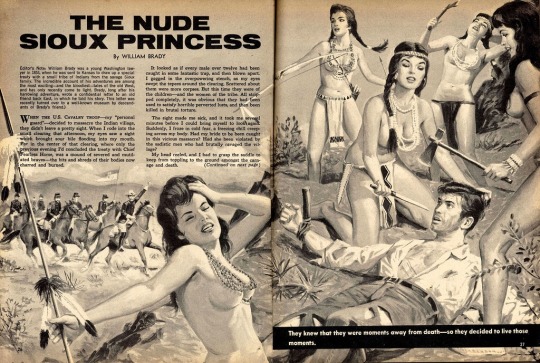
Female Native American retribution for the massacre of a peaceful Cheyenne village at Washita in 1868 by George Armstrong Custer’s Seventh Cavalry. Eight years later, these young women, girls when their parents were slaughtered by the rampaging troopers, have not forgotten. On the bluffs overlooking the Little Big Horn River, Little Elk knelt to take her revenge on Corporal Charles Parrish, also present at the Washita, but now bound and staked out under the hot sun, as the Cheyenne princess, watched by her fellow female braves, her blade glinting, went to take the first scalp of Custer’s disastrous campaign,
Source: The Nude Sioux Princess by William Brady, Man’s Action magazine (July 1962).
6 notes
·
View notes
Note
me borraron mi antiguo blog y por fin te encuentro de nuevo washita rica, gracias por existir
<3
ñauu de nada🤭
2 notes
·
View notes